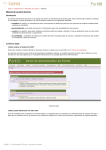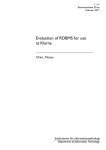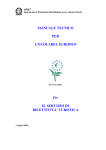Download Mnemosyne (MNEMOSYNE)
Transcript
Mnemosyne (MNEMOSYNE)
version 1.2
Typeset in LATEX from SGML source using the DOCBUILDER 3.4.1 Document System.
Contents
1 Mnemosyne User’s Guide
1.1
1.2
2
Introduction
1
. . . . . . . . . . . . . . . . . . . . . . . . . . . . . . . . . . . . . . . . .
1
1.1.1 Scope and Purpose . . . . . . . . . . . . . . . . . . . . . . . . . . . . . . . . . .
1
1.1.2 Pre-requisites . . . . . . . . . . . . . . . . . . . . . . . . . . . . . . . . . . . . .
1
Database Queries
. . . . . . . . . . . . . . . . . . . . . . . . . . . . . . . . . . . . . .
2
1.2.1 Mnemosyne - the Mnesia Query Language . . . . . . . . . . . . . . . . . . . . .
2
1.2.2 Evaluating Queries . . . . . . . . . . . . . . . . . . . . . . . . . . . . . . . . . .
7
1.2.3 Query Examples . . . . . . . . . . . . . . . . . . . . . . . . . . . . . . . . . . .
8
1.2.4
Matching . . . . . . . . . . . . . . . . . . . . . . . . . . . . . . . . . . . . . . .
11
1.2.5
Matching in Record Fields . . . . . . . . . . . . . . . . . . . . . . . . . . . . . .
13
Mnemosyne Reference Manual
15
2.1
16
mnemosyne . . . . . . . . . . . . . . . . . . . . . . . . . . . . . . . . . . . . . . . . .
List of Tables
23
Mnemosyne
iii
iv
Mnemosyne
Chapter 1
Mnemosyne User’s Guide
1.1
Introduction
Mnemosyne is a query language of Mnesia and provides a simple syntax for complex queries.
Note:
QLC (Query List Comprehensions) is another solution for queries to Mnesia, Ets and Dets tables
which will be the recommended way to perform queries. QLC belongs to Stdlib and is described
there.
It is not recommended to use Mnemosyne queries in performance critical applications.
Mnesia is a distributed DataBase Management System, utilized for telecommunications applications
and other Erlang applications which require continuous operation and soft real-time properties. Mnesia
is part of the Open Telecom Platform (OTP), which is a control system platform for building
telecommunications applications.
1.1.1 Scope and Purpose
This manual is included as a part of the OTP document set. It describes how to use Mnemosyne
queries. Programming constructs are described, and numerous programming examples are included to
illustrate the use of Mnemosyne.
1.1.2 Pre-requisites
It is assumed that the reader is familiar with system development principles and database management
systems. Readers are also assumed to be familiar with the Erlang programming language in general, and
the Mnesia application in particular.
Mnemosyne
1
Chapter 1: Mnemosyne User’s Guide
1.2
Database Queries
This chapter describes Mnemosyne, the Mnesia database query language, and the syntax, semantics, and
rules which apply to Mnesia queries. The following sections are included:
Mnemosyne - the Mnesia query language
Evaluating queries
Mnesia query examples
Matching
Generated functions
The following notational conventions are used in this chapter:
Reserved words and symbols are written like this: table.
Syntactic categories are written like this:
<pattern>.
1.2.1 Mnemosyne - the Mnesia Query Language
Mnemosyne is the query language and the optimizing query compiler for the Mnesia Database
Management System.
General Information about Queries
Database queries are used when more complex operations than just a simple key-value lookup are
required on a database. A query can find all records in a table that fulfills a given property. For example,
think of a table storing the status of subscriber lines in a telephone exchange. A query in such a table
can take the format: “Which subscriber lines are ’blocked’?”.
A query can also find records on the basis of their relationship to other records in the same table, or in
other tables. If the table, which stores subscriber lines, is accompanied by a table, which pairs subscriber
numbers with a subscriber line identification, we can modify our previous query and ask: “Which
subscriber numbers are ’blocked’ ?”. This can be answered by constructing a query, which finds the
blocked subscriber line identifications in the subscriber line table, and then finds the associated
subscriber number in the table, which pairs subscriber number and subscriber line identifications.
However, the proposed solution may not be the most efficient solution, because it depends on what the
tables look like in runtime. In other words, how many records the table contains, and the number of
different values stored.
In a situation where there are only a couple of subscriber numbers but a million blocked lines, it would
be far more efficient to first find the subscribers and then check if their line is blocked. The query
evaluation order depends on how large the tables are compared to each other. The evaluation order also
depends on key and other value distribution, and if there are any indices defined (refer to Mnesia
Chapter 5: Indexing for more information).
The query compiler resolves the evaluation order. We need only express what we want to do, and the
query compiler and query evaluator will determine the best evaluation order. Therefore, we can express
the query in the most readable form.
2
Mnemosyne
1.2: Database Queries
Queries in Mnesia
Queries in Mnemosyne use first order predicate logic (similar to Prolog), but in an syntax suitable for
Erlang. The “query list comprehension” used in Mnemosyne is taken from the functional languages
community. The advantage over embedded SQL, is that the constructs integrate smoothly with the
Erlang language.
To illustrate the Mnemosyne query language, we will show the Erlang code for the subscriber line and
subscriber number tables discussed above. We define two tables subscriber and line. Their
corresponding record declarations in the file subscriber.hrl are:
-record(subscriber, {snb,
cost_limit,
li}).
-record(line, {li,
state}).
The query “which subscriber numbers are blocked?” can also be expressed as “which subscribers have
lines which are in state ’blocked”’. This query can be coded as follows:
query
[ S.snb ||
S <- table(subscriber),
L <- table(line),
L.state = blocked,
L.li = S.li
]
end
%
%
%
%
%
collect the subscriber number
where S is taken from the subscriber table
and L is taken from the line table
and the state of that line is blocked
and L and S uses the same li
In the example above, the aim is to get an answer from a logical relation. Consider also the following
example:
query [E.name || E <- table(employee),
E.sex = female]
end
This means “the Erlang list of all female employees”. A formulation closer to the list comprehension is:
“the Erlang list of all names of E such that E is in the table employee and E’s sex is female”.
Some words have a direct correspondence to the elements in the list comprehension notation:
the Erlang list of all
such that
[ ]
||
is in
<-
and
,
Table 1.1: Natural Language Translation
Another query component is rules, which can be compared to views in Relational Databases, where the
purpose is to define a “virtual table”. This “table” looks like an ordinary table to the user, which means
Mnemosyne
3
Chapter 1: Mnemosyne User’s Guide
that queries can be formulated on stored data (as well as views). In the subscriber line example, a rule
can give the subscriber number and the corresponding line status from both tables, and there is no need
to create a third table.
The rule is a definition of how to calculate the records on demand from a query. In Erlang modules,
rules are written with the same syntax as the bodies in the query list comprehensions. They are
exported and can be used by other modules.
Our subscriber example formulated as a rule would look as follows:
blocked_subscribers(S, subscriber) :S <- table(subscriber),
L <- table(line),
L.state = blocked,
L.li = S.li.
This rule can be used in a query in the same manner as a table but with the keyword rule substituted
for table.
query [ S.snb || S <- rule(blocked_subscribers) ] end
Query Syntax
Database queries can be included in an Erlang program, but there must be a directive in the Erlang file
which informs the compiler about its behavior towards queries. This directive is:
-include_lib("mnemosyne/include/mnemosyne.hrl").
The high-level syntax of the query list comprehension is:
query [ <pattern> || <body> ] end
The <body> is a comma-separated sequence of:
<logical-variable> <- table( <table-name> [ , <table-type> ]
2. <logical-variable> <- rule( <rule-name> )
3. <logical-variable> <- rule( <rule-name> )
4. <logical-variable> <- rule( <module> : <rule-name> ])
5. <logical-variable> <- <erlang-list-expression>
6. <expression> <relop> <expression>
7. <erlang-test-expression>
The <relop> operators are:
1.
= for unification
/= for not unification
4
< for less than
> for greater than
=< for equal to or less than
>= for equal to or greater than.
Mnemosyne
)
1.2: Database Queries
A <logical-variable> is written exactly as an Erlang variable. The <table-name>, <table-type>,
<rule-name> and <module> are atoms. The <table-name> and <table-type> can also be an
Erlang variable. The logical variables are local to a list comprehension and shadows any Erlang variable
with the same name.
The <pattern> is an Erlang term without function calls. It may contain (bound) Erlang variables and
it usually has one or more <logical-variable>, since these are used to get data out from the query
body and into the produced list.
An <expression> is any Erlang expression which may include function calls and
<logical-variable>. The variant <erlang-list-expression> is an <expression> which must
produce a list where all elements are records of the same type.
The <erlang-test-expression> is an <expression> which has the values true or false.
Erlang variables are allowed in all variations of <expression> and in <pattern>. They must be
bound in the query list comprehension.
Query Semantics
The constructs used in the Mnemosyne query language have the following meanings:
Comma. The comma, used to separate different body elements, is equivalent to “and”. Thus, the
body can be viewed as a collection of tests and statements which should be true for each solution
which is produced when evaluating the query list comprehension. Refer to subscriber query [page
3] as an example of this.
<logical-variable> <- .... This expression means that the variable is taken from the values
in the expression to the right of the arrow. For example, E <- [#efa=1g, #efa=2g] says that E
takes the values #efa=1g, or #efa=2g
<-. These constructs usually generate values. However, if the logical variable is bound it tests that
value. If a test fails it means that the query tries another alternative. For example:
query [ X.a || X <- [#e{a=1}, #e{a=2}],
X <- [#e{a=3}],
.... ]
end
The body means that the field ’a’ of X should be 3 and at the same time either 1 or 2. So the list of
solutions will always be empty.
The test <expression> <relop> <expression> and the true-or-false returning test
<erlang-test-expression> simply filters out the solutions. The purpose of the latter test is to
provide user defined data tests.
We will next consider the logical variables associated records in an expression like x
have already established the following rules and assumptions:
<-
table(a). We
1. the values stored in tables are records
2. all records in a table must be of the same type
3. by default, the record definition has the same name as the table itself
4. The <logical-variable> must have the same record association as the records produced by the
right side of the <- constructs.
Mnemosyne
5
Chapter 1: Mnemosyne User’s Guide
In the example X <- table(a), the associated record of x is a because table a stores records with the
name a. Since release 3.4 of Mnesia it has been possible to separate record name and its table type. If
the type of the table is different from its name, this can be specified in Mnemosyne using X <table(Name, Type) where Name is the Name of the table and Type is the record name.
Similar to tables, rules produce or test records. The return type for a rule is by default the name of the
rule. Rules can be declared to return other types. This makes it possible to construct a rule for some
special cases with a name like blocked subscriber which still produces or tests subscriber records.
In Erlang we must always tell the compiler which record definition it should use by putting the record
name after a hash mark. In general, this is not needed in Mnemosyne since, in most cases, the query
compiler can deduce the associated record. That is the reason S.li is acceptable instead of the full
S#subscriber.li. It will not cause an error if the longer version was written, but if we do write the
record name it must be the same record name as the one the query compiler deduces. Sometimes the
compiler is unable to find the associated record. When this happens, an error message is issued. It is also
preferred to write out the type of the associated record for performance reasons. If the associated
record is part of a complex constraint, the constraint may be compiled to a function if the type of the
associated record is known (explicitly or deducable) at Erlang compile time.
Note:
A function used in a query list comprehension must never directly or indirectly:
1. have side effects;
2. access the database neither by a query nor by Mnesia functions;
3. spawn processes, or;
4. send or receive messages.
Rules
A rule is composed of clauses and each clause has the structure:
<head> :- <body>
The clauses are separated by semicolon, and the rule is terminated by a dot.
The <head> looks like an Erlang function with one or two arguments, where the first argument is
a variable and the second, optional, argument an atom. If there is a second argument, it must be
present in all clauses and have the same value.
The <body> has the same syntax as the <body>. in query list comprehensions [page 4]
The argument variable of a rule clause has an associated record.
The default associated record is the name of the rule. This can be changed by declaring the
associated record type in the head of the clause:
<rule-name> (<return-var>, <record-name>)
The syntax used in previous mnemosyne versions, by declaring the the associated recordtype with
an argtype declaration still works but is depreciated.
6
Mnemosyne
1.2: Database Queries
Note:
The <logical-variable> mentioned in the <head> must also occur in the <body>.
Review the rule example [page 4].
blocked_subscribers(S, subscriber) :S <- table(subscriber),
L <- table(line),
L.state = blocked,
L.li = S.li.
It produces a list of subscriber records. Rules with a single argument return records of the same type
as the name of the rule. For example, the following rule produces records of type blocked
-record (blocked, {snb, li}).
blocked (X) :S <- table (subscriber),
L <- table(line),
L.state = blocked,
L.li = S.li,
X = #blocked{snb=S#subscriber.snb, li=S#subscriber.li}.
1.2.2 Evaluating Queries
The previous sections described how to define queries. This section describes how to evaluate queries.
The principle is simple: query list comprehensions, compile and optimize the query and return a
handle. This handle is then passed on for execution:
Handle =
query
[ S.snb || S <- table(subscriber),
S.li = none]
end,
AllAnswers =
mnesia:transaction(
fun() ->
mnemosyne:eval(Handle)
end)
There are three ways of evaluating queries. The mnemosyne:eval/1 is the simplest of the three. It takes
a handle and returns all solutions. Sometimes we only need to view a few solutions, examine them and
possibly get more. Think of an airline routing database: you do not want to know all possible
connections between two cities, but usually enough information is given after observing one or two.
Use the cursor with a query evaluation to produce a few solutions only. With a handle we create a
cursor by calling mnemosyne:cursor/1. With the cursor we can repeatedly call
mnemosyne:next answers to get more solutions. When an empty list is returned there are no more
possible solutions. Delete the cursor with mnemosyne:delete cursor/1.
Mnemosyne
7
Chapter 1: Mnemosyne User’s Guide
Handle =
query
[ S.snb || S <- table(subscriber),
S.li = none]
end,
AFewAnswers =
mnesia:transaction(
fun() ->
Cursor = mnemosyne:cursor(Handle),
% now get at least two but not
% more than five solutions:
L = mnemosyne:next_answers(Cursor,2,5),
mnemosyne:delete_cursor(Cursor),
L
end)
A query evaluation can be time consuming, but can be broken up by using the cursor with
setup query/1 and init query/1:
Handle =
query
[ S.snb || S <- table(subscriber),
S.li = none]
end,
QuerySetup = mnemosyne:setup_query(Handle),
AFewAnswers =
mnesia:transaction(
fun() ->
Cursor = mnemosyne:init_query(QuerySetup),
mnemosyne:next_answers(Cursor, 5, 5)
end),
% Here we may call more init_query-next_answers constructions
% with the same Handle. Note that the query is evaluated from
% "scratch" because of the call to mnemosyne:init_query/1.
mnemosyne:delete_query(QuerySetup)
Because of table updates, a query which is compiled and optimized may be incorrect when the handle
returns. This can be rectified with the function mnemosyne:reoptimize/1 which takes a handle,
re-optimizes the query and returns a new handle.
1.2.3 Query Examples
This section describes an example which illustrates the use of Mnemosyne. The example given is of a
simplified local exchange, with AXE-10 exchange as a model. The purpose of this section is to show
different constructs in a telecom environment. It should not be taken as a proposed data model for a
modern telecom system.
Our telephone example includes the following components, relationships, and events:
8
Mnemosyne
1.2: Database Queries
The exchange has a number of subscribers.
Each subscriber has a subscriber number, which is abbreviated snb.
Each physical line enters the exchange through a line interface card. Lines are abbreviated li.
The li has an associated status which indicates if the line is blocked, or available.
One single table stores the accumulated cost for each subscriber.
Program Definitions
We identify three tables:
subscriber with subscriber numbers snb, line interface number li, and a maximum cost
cost limit which must not be exceeded.
line with line interface number li, and its state.
account, a table which stores the cost of calls. It has an snb field, and the accumulated cost in
cost.
The corresponding record definitions are stored in a file named subscriber.hrl, which has the
following record definitions:
-record(subscriber, {snb,
cost_limit,
li}).
-record(line, {li,
state}).
-record(account, {snb,
cost}).
The program file is titled subscriber.erl. It declares the module name subscriber, calls the record
definition in subscriber.hrl, and Mnesia query support mnemosyne.hrl.
-module(subscriber).
-compile(export_all).
-include("subscriber.hrl").
-include_lib("mnemosyne/include/mnemosyne.hrl").
We then create the required tables and load data by entering table definitions into a file named
subscriber.tables, which has the following content:
{tables,
[{subscriber, [{attributes, [snb,cost_limit,li]}]},
{line, [{attributes, [li, state]}]},
{account, [{attributes, [snb, cost]}]}
]
}.
%% Subscribers
{subscriber, 1230,
0,
none}.
Mnemosyne
9
Chapter 1: Mnemosyne User’s Guide
{subscriber,
{subscriber,
{subscriber,
{subscriber,
{subscriber,
{subscriber,
{subscriber,
{subscriber,
{subscriber,
1231,
0,
none}.
1232,
0,
none}.
1233,
0,
none}.
1234, 100, {li,1}}.
1235, 200, {li,3}}.
1236, 150, {li,2}}.
1237,
0,
none}.
1238,
0,
none}.
1239,
0,
none}.
%% Lines
{line, {li,0},
{line, {li,1},
{line, {li,2},
{line, {li,3},
{line, {li,4},
{line, {li,5},
{line, {li,6},
{line, {li,7},
blocked}.
normal}.
normal}.
blocked}.
blocked}.
blocked}.
blocked}.
blocked}.
%% Accounts
{account, 1234,
{account, 1235,
{account, 1236,
{account, 1237,
0}.
0}.
0}.
0}.
Program Output
In our program, this file is called with the statement:
mnesia:load_textfile("subscriber.tables")
To retrieve a list of all free subscriber numbers we call the following function in a transaction:
free_subscriber_numbers() ->
mnemosyne:eval(
query [ S.snb || S <- table(subscriber),
S.li = none]
end
).
The rule too high cost/0 locates and returns all subscribers with an accumulated cost that exceeds
their limit:
limit_exceeded(S, subscriber) :S <- table(subscriber),
A <- table(account),
A.snb = S.snb,
A.cost > S.cost_limit.
10
Mnemosyne
1.2: Database Queries
We could find all subscriber numbers of subscribers who have exceeded their cost limit as follows:
Q = query
[ S.snb || S <- rule(limit_exceeded) ]
end
1.2.4
Matching
Mnesia provides the programmer with a method of matching objects against a pattern. This is the
Mnesia matching function:
mnesia:match object(Pattern) ->transaction abort | ObjList.
This function matches Pattern for objects. A Pattern is a tuple with the name (identity) of the table
as the first element. The table collates all data retrieved.
In comparison to a list comprehension query, mnesia:match object is a low level function. The
following two functions both return the same objects; however, the second example uses matching.
f1() ->
Q = query
[E || E <- table(employee),
E.sex = female]
end,
F = fun() -> mnemosyne:eval(Q) end,
mnesia:transaction(F).
and
f2() ->
WildPat = mnesia:table_info(employee, wild_pattern),
Pat = WildPat#employee{sex = female},
F = fun() -> mnesia:match_object(Pat) end,
mnesia:transaction(F).
The pattern supplied to the mnesia:match object/1 function must be a valid record, and the first
element of the provided tuple must be a valid table name. The special element ’ ’ matches all the
records.
There are advantages in using the Mnemosyne query syntax instead of the mnesia:match object/1
function:
The pattern is computed in compile time by the Mnemosyne compiler instead of doing it in run
time in the f2/0 function.
Mnemosyne provides more sophisticated evaluation optimizations based on indices and on
statistics from and about the table.
Whereas, the optimizations that mnesia:match object/1 function provides are limited in both
scope and number. The mnesia:match object function is also performed during run time, which
in turn reduces performance.
The Mnemosyne query syntax is quite compact and makes it easier to express complex queries.
It is also possible to use the match function if we want to check the equality of different attributes.
Assume we have the following record definition:
Mnemosyne
11
Chapter 1: Mnemosyne User’s Guide
-record(foo, fa, b, cg).
The pattern ffoo, ’$1’, ’$1’, ’ ’g then extracts all objects of type foo where the first two
attributes have the same value.
If the key attribute is bound in a pattern, the match operation is very efficient. The pattern ffoo, 123,
’ ’, elvisg can be used to extract all objects with key 123, and the last attribute set to the atom
elvis. This is the same as extracting all the elvis objects from the result of mnesia:read(ffoo,
123g), but more efficient.
If the key attribute in a pattern is given as ’ ’, or ’$1’, the whole foo table must be searched for
objects that match. If the table is large, this may be a time consuming operation. This can be remedied
with indices (refer to Mnesia Chapter 5: Indexing for more information).
This chapter closes with an example of information extraction from a Company database:
all employees who have a salary higher than X.
all employees who work in the Dep department.
The first example demonstrates the query execution with list comprehension notation. The second
example illustrates a query coded with a matching function.
The list comprehension based implementation looks as follows:
get_emps(Salary, Dep) ->
Q = query
[E || E <- table(employee),
At <- table(at_dep),
E.salary > Salary,
E.emp_no = At.emp,
At.dept_id = Dep]
end,
F = fun() -> mnemosyne:eval(Q) end,
mnesia:transaction(F).
The data model for the Company database introduced in the Mnesia documentation was designed to
facilitate the posting of queries like the one shown above.
To implement the same query by directly searching the database is more complex. The following
function does precisely this:
get_emps2(Salary, Dep) ->
Epat = mnesia:table_info(employee, wild_pattern),
Apat = mnesia:table_info(at_dep, wild_pattern),
F = fun() ->
All = mnesia:match_object(Epat),
High = filter(All, Salary),
Alldeps = mnesia:match_object(Apat),
filter_deps(High, Alldeps, Dep)
end,
mnesia:transaction(F).
filter([E|Tail], Salary) ->
if
12
Mnemosyne
1.2: Database Queries
E#employee.salary > Salary ->
[E | filter(Tail, Salary)];
true ->
filter(Tail, Salary)
end;
filter([], _) ->
[].
filter_deps([E|Tail], Deps, Dep) ->
case search_deps(E#employee.name, Deps, Dep) of
true ->
[E | filter_deps(Tail, Deps, Dep)];
false ->
filter_deps(Tail, Deps, Dep)
end;
filter_deps([], _,_) ->
[].
search_deps(Name, [D|Tail], Dep) ->
if
D#at_dep.emp == Name,
D#at_dep.dept_id == Dep -> true;
true -> search_deps(Name, Tail, Dep)
end;
search_deps(Name, Tail, Dep) ->
false.
The function mnesia:match object/1 will automatically make use of indices if any exist. However, no
heuristics are performed in order to select the best index, if more than one exists.
As can be seen, the list comprehension provides a more elegant solution.
1.2.5
Matching in Record Fields
There is a difference when matching record fields in a mnemosyne list comprehension and in Erlang in
general (for example, a function clause header). The following code returns true for all employee where
emp id is 312 or 400:
test_employee(#employee{emp_id = 312}) -> true;
test_employee(#employee{emp_id = 400}) -> true;
test_employee(_) -> false.
That is, it does not check other fields of the employee record. Compare that with the following
mnemosyne query:
query [E || E <- table(employee),
E <- [#employee{emp_id=312},
#employee{emp_id=400}]]
Mnemosyne
13
Chapter 1: Mnemosyne User’s Guide
The query will return all employees from the employee table whos emp id is either 312 or 400 and have
the other fields set to the default values for an employee. To select all items that have a field set to some
values (disregarding the other fields) the constraint can be put in separate function. For example, select
all employees whos emp id is either 312 or 400 independently of other fields:
query [E || E <- table(employee),
test_employee(E)]
test_employee(#employee{emp_id = 312}) -> true;
test_employee(#employee{emp_id = 400}) -> true;
test_employee(_) -> false.
If there is only one acceptable value for a record field it is more efficient to write it directly in the query.
Select employees whos emp id is 312:
query [E || E <- table(employee),
E#employee.emp_id = 312]
14
Mnemosyne
Mnemosyne Reference Manual
Short Summaries
Erlang Module Mnemosyne [page 16] – A query language support for the DBMS
Mnesia
Mnemosyne
The following functions are exported:
all answers(Cursor) -> Answer
[page 18] Return all answers from Cursor in a list
cursor(Handle) -> Cursor
[page 18] Create a cursor in preparation for fetching answers
cursor(Handle,Nprefetch) -> Cursor
[page 18] Create a cursor in preparation for fetching answers
delete cursor(Cursor)
[page 18] Stop the query associated with Cursor
delete query(QuerySetup)
[page 18] Delete a query setup.
eval(Handle) -> Answers
[page 18] Get all answers from the Handle
init query(QuerySetup) -> Cursor
[page 18] Quick query initialization
init query(QuerySetup,Nprefetch) -> Cursor
[page 18] Quick query initialization
next answers(Cursor) -> Answers
[page 18] Fetche the next answers
next answers(Cursor,Nmin,Nmax) -> Answers
[page 18] Fetche the next answers
reoptimize(Handle) -> Handle
[page 18] Optimize a query
setup query(Handle) -> QuerySetup
[page 19] Create a query setup
version() -> String
[page 19] Mnemosyne module version
Mnemosyne
15
mnemosyne
Mnemosyne Reference Manual
mnemosyne
Erlang Module
Queries are used for accessing the data in a Database Management System. The query
specifies a relation (possibly complicated) to all of the selected data. This could involve
several tables as well as conditions such as ’<’ (less than), function calls and similar.
Mnesia has two query interfaces which are used together:
Mnemosyne, which is this module
QLC (Query List Comprehensions), an Erlang language construct for the queries.
This will be the recommended way to perform queries
The exact syntax of query list comprehensions are described in a separate section [page
19] of this document.
The query list comprehensions only define the query and the syntax of the solutions to
be returned. The actual evaluation is determined by calling different functions with a
handle obtained by the list comprehension. For example:
-record(person, {name,age}).
Handle =
query
[ P.name || P <- table(person) ]
end,
L = mnesia:transaction(
fun() ->
mnemosyne:eval(Handle)
end)
The example above matches a list of all names in the table “person” with the variable L.
Note the following points:
Each database table must have a corresponding record declaration.
A query is declared with
query [ <pattern> || <body> ] end
where <pattern> is an Erlang term without function calls. The notation P.name
means that P is a variable and it has an associated record with a field name which
we use. The <body> is a sequence of conditions separated by commas. In the
example, we have P <- table(person) which means: “P is taken from the
table person”.
The whole query could therefore be read as follows: “Make the list of all names of
P such that P is taken from the table person”.
However, the query list comprehension does not return the answers but a handle.
This handle is used as an argument for different evaluation functions which do the
actual query processing. In the example we used the simplest, eval/1, which
evaluates the query and returns all the answers.
16
Mnemosyne
Mnemosyne Reference Manual
mnemosyne
Some parts of the query must be evaluated in a Mnesia transaction or by utilizing
an alternative Mnesia access context. These functions are marked in the function
descriptions below.
After obtaining a handle from a query list comprehension, the query can be evaluated in
three different ways:
A simple all-answer query as in the example shown above. This function is eval/1.
Getting the answers in small or large chunks. The query may be aborted when
enough solutions have been obtained. These are called cursors. The functions are
cursor/1, cursor/2, next answers/1, next answers/3, all answers/1,
all answers/3, and delete cursor/1.
An even more sophisticated cursor version where the time consuming part of the
cursor creation can be done in advance. The functions are setup query/1,
init query/1, init query/2, next answers/1, next answers/3, all answers/1,
all answers/3, and delete query/1.
Let us reconsider the previous example, this time with cursors. In the following
example, we will get just five names without evaluating all of the answers:
-record(person, {name,age}).
Handle =
query
[ P.name || P <- table(person) ]
end,
L = mnesia:transaction(
fun() ->
Cursor = mnemosyne:cursor(Handle),
As = mnemosyne:next_answers(Cursor, 5, 5),
mnemosyne:delete_cursor(Cursor),
As
end)
The third way of evaluating a query is by a further division of the query process. The
cursor/1 function is now split into two. The reason for this is that we can set up the
query when there is plenty of time and initialize it when answers are needed quickly. As
in the previous example, we will get just five names:
-record(person, {name,age}).
Handle =
query
[ P.name || P <- table(person) ]
end,
QuerySetup = mnemosyne:setup_query(Handle),
L = mnesia:transaction(
fun() ->
Cursor = mnemosyne:init_query(QuerySetup),
mnemosyne:next_answers(Cursor, 5, 5)
end),
% Here we may call more init_query-next_answers constructions
% with the same Handle
mnemosyne:delete_query(QuerySetup)
Mnemosyne
17
mnemosyne
Mnemosyne Reference Manual
Exports
all answers(Cursor) -> Answer
Returns all remaining answers from the query identified by Cursor. It can be applied
after next answers to obtain all answers that are left.
Note: This must be evaluated inside a transaction.
cursor(Handle) -> Cursor
cursor(Handle,Nprefetch) -> Cursor
Sets up a query for evaluation and starts an answer pre-fetch. Nprefetch gives the
number of answers to pre-fetch and must be greater than 0. The default value is 1. A
pre-fetch is the first part of a query evaluation. It is placed in a separate process which
may on some occasions speed up the subsequent collection of answers.
Note: This must be evaluated inside a transaction.
delete cursor(Cursor)
Deletes the Cursor and associated query evaluation.
Note: This must be evaluated inside a transaction.
delete query(QuerySetup)
Deletes a query setup.
eval(Handle) -> Answers
Starts a query evaluation according to the Handle and collects all answers in one
operation.
Note: This must be evaluated inside a transaction.
init query(QuerySetup) -> Cursor
init query(QuerySetup,Nprefetch) -> Cursor
Performs the last short step in starting a query from QuerySetup. Nprefetch defines the
number of answers to pre-fetch as in cursor/2. The default value is 1.
Note: This must be evaluated inside a transaction.
next answers(Cursor) -> Answers
next answers(Cursor,Nmin,Nmax) -> Answers
Fetches the next answers from the query evaluation identified by Cursor. At least Nmin
and at most Nmax answers are collected. If less than Nmin answers are returned; for
example, 0, there are no more answers. If enough answers are not available, but more
are expected, the functions wait for them.
Note: This must be evaluated inside a transaction.
reoptimize(Handle) -> Handle
18
Mnemosyne
Mnemosyne Reference Manual
mnemosyne
Re-optimizes a query. Queries are always optimized, but the optimization takes into
account the dynamic table statistics like size, attribute distribution etc. If a table has
changed after obtaining the Handle from a query list comprehension, the query
execution plan will no longer be appropriate (although semantically correct). This
function will rearrange the execution plan according to the current statistics from the
database.
setup query(Handle) -> QuerySetup
Creates a query setup, that is, performs most of a query evaluation without actually
initiating the actual evaluation.
version() -> String
Returns the current module version.
List Comprehension
There must be a directive in the Erlang file telling the compiler how to treat queries.
This directive is:
-include_lib("mnemosyne/include/mnemosyne.hrl").
A list comprehension consists of:
query [ <pattern> || <body> ] end
The <pattern> is a description of the terms that are returned by a query. Details of
how to obtain the actual values in the <pattern> is given by the <body>.
The <pattern> is an Erlang term without function calls. It typically has one or more
variables from the <body> which are instantiated for each answer produced. Every
element in the returned list is composed by instantiating this <pattern> and then
adding it to the answers.
The <body> takes a sequence of goals separated by “,”. The possible goals are:
<logical-variable> <- table( <table-name> [ , <table-type> ] )
<logical-variable> <- rule( <rule-name> )
<logical-variable> <- rule( <module> : <rule-name> )
<logical-variable> <- <erlang-list-expression>
<expression> <relop> <expression>
<erlang-test-expression>
A <logical-variable> is written exactly as an Erlang variable. The <table-name>,
<table-type>, <rule-name> and <module> are atoms. The <table-name> and
<table-type> may be an Erlang variable which must be bound at runtime. The logical
variables are local to a list comprehension and shadows any Erlang variables with the
same name.
An <expression> is any Erlang expression which may include function calls and
<logical-variable>. The variants <erlang-list-expression> is an
<expression> which must produce lists where all elements are records of the same
type. The <logical-variable> must have the same associated record. The
Mnemosyne
19
mnemosyne
Mnemosyne Reference Manual
<erlang-test-expression> is an <expression> which only has the values true or
false.
Erlang variables are allowed in all variants of <expression> and in <pattern>. They
must always be bound in the query list comprehension.
logical variables is local to a query list comprehension and have an associated Erlang
record. The associated record can in most cases be inferred by the query compiler.
Therefore, the normal notation for the field f1 in variable X is just X.f1. The query
compiler notifies when it cannot deduce the corresponding record. The explicit form is
X#r.f1 as in ordinary Erlang. If the type of the record is not deducable at Erlang
compile time, it is more efficient to use the explicit form as a help to the compiler. A
variable receiving values from a table will have the record with the same name as the
table.
Erlang variables are allowed in <expression> and in some places as described above.
They must always be bound in the query list comprehension.
Errors in the description are reported as exceptions in the Erlang standard format as
follows:
{error, {Line,Module,Msg}}
The descriptive English text is returned by calling
Module:format_error(Msg)
Note:
A function used in a query list comprehension must never directly or indirectly:
1. have side effects
2. access the database either by a query
or by Mnesia functions
3. spawn processes
4. send or receive messages
Rules (Views)
A rule (or view) is a declaration of how to combine data from sources as a kind of
“subroutine”. Assume that we have the following query list comprehension:
query
[ Employee || Employee <- table(employee),
Employee.department = sales ]
end
This retrieves a list of all sales employees. This could be formulated in the following
rule:
sales(E, employee) :E <- table(employee),
E.salary = sales.
20
Mnemosyne
Mnemosyne Reference Manual
mnemosyne
The employee declaration in the head of the rule forces the rule argument to associate
the employee record. If we omit the declaration, then the associated record would be
the rule name, in this case sales. Note that the syntax used in previous versions of
Mnemosyne by using an separate argtype declaration still works, but the above method
is prefered.
The sales rule may now be used in a query list comprehension:
query
[ SalesPerson || SalesPerson <- rule(sales) ]
end
The SalesPerson is an employee record because of the declaration of the rule above.
Another example lists the names of all female sales people:
query
[ SalesPerson.name || SalesPerson <- rule(sales),
SalesPerson.sex = female
]
end
The rule must have one argument when used. Although the declaration of a rule looks
similar to an ordinary function, no function of that name is constructed. Hence the
name of the rule can be used for another function. All rules are automatically exported
so they could be referred in other modules by the usual notation module:name. After
the :-, there is the usual <body> as in the query list comprehension.
Generated Functions
When compiling queries some extra (hidden) functions are automatically generated and
exported. Thus, there cannot be other functions with the same name and arity within
the module. Three such generated functions exist. They are:
MNEMOSYNE QUERY/2
MNEMOSYNE RECFUNDEF/1
MNEMOSYNE RULE/1
Mnemosyne
21
mnemosyne
22
Mnemosyne Reference Manual
Mnemosyne
List of Tables
1.1 Natural Language Translation . . . . . . . . . . . . . . . . . . . . . . . . . . . . . . . . .
Mnemosyne
3
23
List of Tables
24
Mnemosyne
Index of Modules and Functions
Modules are typed in this way .
Functions are typed in this way.
all_answers/1
mnemosyne , 18
next_answers/3
mnemosyne , 18
cursor/1
mnemosyne , 18
reoptimize/1
mnemosyne , 18
cursor/2
mnemosyne , 18
delete_cursor/1
mnemosyne , 18
delete_query/1
mnemosyne , 18
setup_query/1
mnemosyne , 19
version/0
mnemosyne , 19
eval/1
mnemosyne , 18
init_query/1
mnemosyne , 18
init_query/2
mnemosyne , 18
mnemosyne
all_answers/1, 18
cursor/1, 18
cursor/2, 18
delete_cursor/1, 18
delete_query/1, 18
eval/1, 18
init_query/1, 18
init_query/2, 18
next_answers/1, 18
next_answers/3, 18
reoptimize/1, 18
setup_query/1, 19
version/0, 19
next_answers/1
mnemosyne , 18
Mnemosyne
25
Index of Modules and Functions
26
Mnemosyne








































